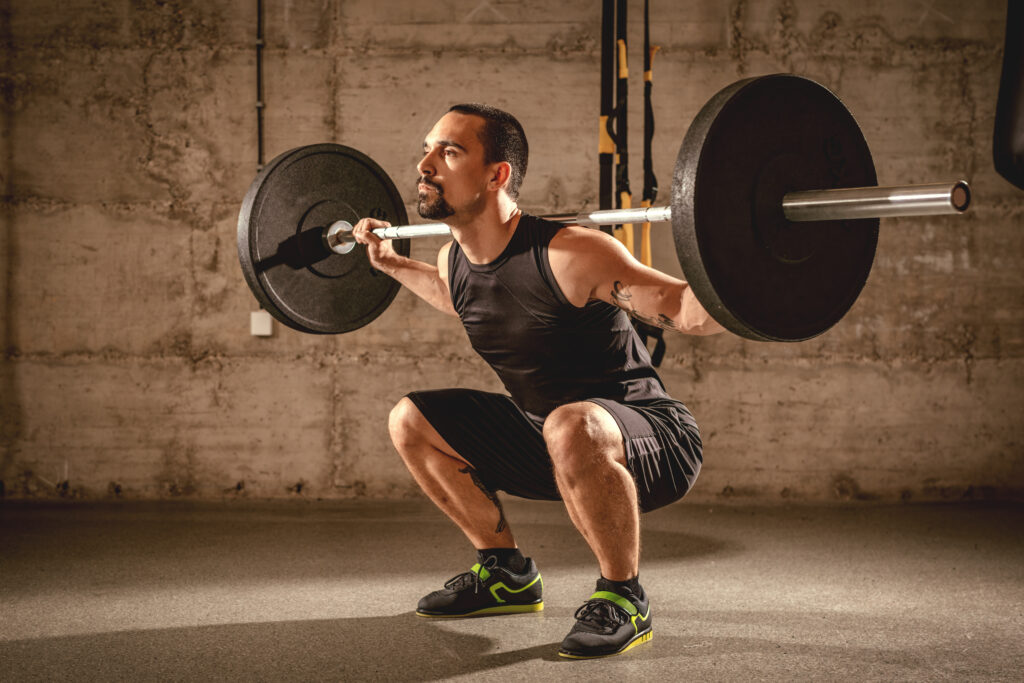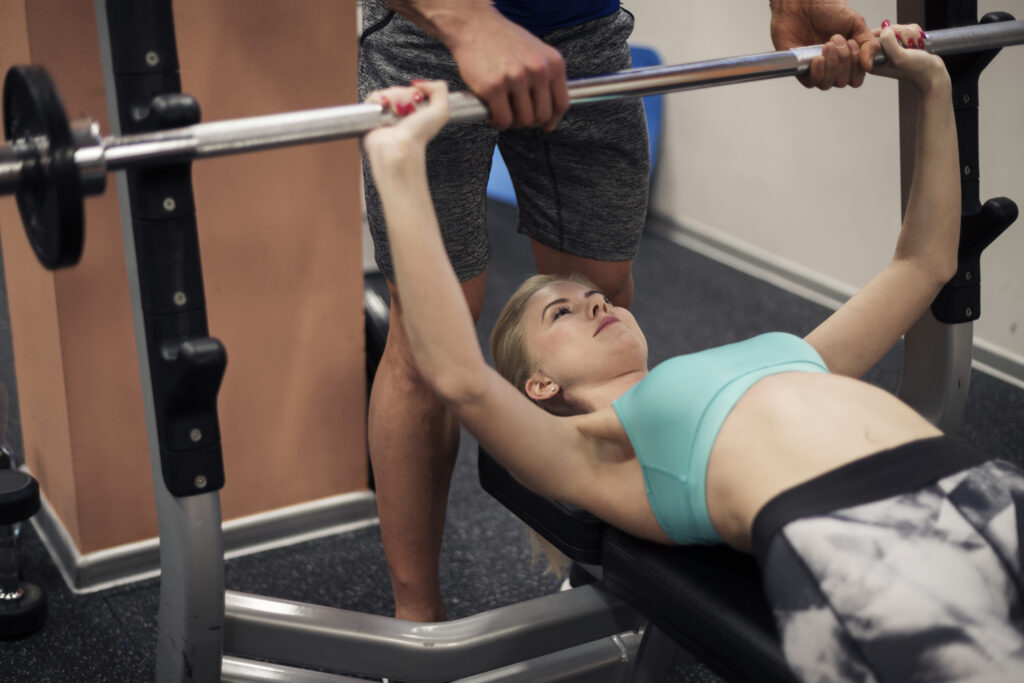Introduction
Strength training, also known as resistance training, is a form of exercise that involves using weights or resistance to build muscular strength and endurance. While many people believe that strength training is solely for bodybuilders or athletes, the truth is that it offers a wide range of benefits for anyone who wants to improve their overall health and fitness.
Explanation of Strength Training
Strength training involves working against an external resistance to make your muscles stronger. This can be achieved by lifting weights, using resistance bands, or even performing bodyweight exercises.
When you perform strength exercises, you create micro-tears in your muscle fibers. Your body then repairs these micro-tears during rest periods by building stronger muscle fibers which help increase the amount of force your muscles can produce.
Importance of Strength Training in Overall Fitness
Strength training has many benefits beyond just building muscular strength. It can improve bone density and reduce the risk of osteoporosis, especially in women over the age of 50. It also helps improve balance and coordination which can prevent falls and injuries as we age.
Strength training is also beneficial for weight loss because it increases metabolism by building lean muscle mass. The more muscle mass you have, the more calories your body burns at rest.
This means that even when you are not exercising, your body will continue to burn calories all day long. Strength training has been shown to have positive effects on mental health such as reducing symptoms of depression and anxiety improving self-confidence and self-esteem.
Incorporating strength training into your exercise routine is essential for overall health and fitness. Whether you are looking to lose weight or simply want to feel stronger and healthier in everyday life, there are numerous benefits associated with this type of exercise that make it well worth including in any fitness program.
Types of Strength Training
Strength training is a versatile activity that can be done with just your bodyweight or with weights and machines. In this section, we will explore the two main types of strength training: bodyweight exercises and weightlifting exercises.

Bodyweight Exercises
Bodyweight exercises are a great way to get started with strength training because they require no equipment and can be done anywhere. They also help you develop core strength, balance, and flexibility. Here are some popular bodyweight exercises:
Push-ups
Push-ups are one of the best upper body exercises you can do because they work your chest, shoulders, triceps, and core at the same time. To perform a push-up, start in a plank position with your hands slightly wider than shoulder-width apart. Lower your body until your chest almost touches the ground and then push back up to plank position.


Squats
Squats are one of the most effective lower body exercises you can do because they work your quads, hamstrings, glutes, and core. To perform a squat, stand with your feet hip-width apart and lower yourself down as if you were sitting in a chair. Keep your weight on your heels and make sure your knees don’t go past your toes.
Lunges
Lunges are another great exercise for working your lower body muscles while improving balance and coordination. To perform a lunge, step forward with one foot while keeping the other foot planted behind you. Lower yourself down until both knees form 90-degree angles before pushing back up to standing position.


Planks
Planks are an excellent exercise for strengthening the muscles in the core of your body, including the abdominals, back muscles and glutes. To perform a plank, get into a prone position on the floor with your forearms flat on the ground and your elbows directly under your shoulders. Raise yourself up on your toes and forearms so that your body is in a straight line from head to feet.
Weightlifting Exercises
Weightlifting exercises involve using weights or machines to add resistance to your movements. Free weights like dumbbells and barbells are popular choices for weightlifting exercises, but you can also use resistance bands or machines at the gym. Here are some popular weightlifting exercises:
Barbell Squats
Barbell squats are one of the most effective weightlifting exercises for developing lower body strength because they work multiple muscle groups at once. To perform a barbell squat, place a weighted bar across the back of your shoulders with both hands grasping it slightly wider than shoulder-width apart. Lower yourself down until both knees form 90-degree angles before pushing back up to standing position.

Deadlifts
Deadlifts are an excellent exercise for building overall body strength as they work multiple muscle groups including legs, back and core muscles.To perform a deadlift, stand with feet hip-width apart while keeping the weights in front of you near feet. Push through heels lifting weights while keeping them close to legs until standing in an upright position.
Bench Press
The bench press is one of the most classic weightlifting moves that works chest muscles such as pectoralis major muscle group.The exercise also activates supporting muscles such as triceps and anterior deltoids .To do this exercise,you will need a bench press machine or just lay flat on bench holding barbells just above chest at shoulder width grip, slowly lower barbell with control until it touches chest before pushing it up back to starting position.


Overhead Press
Overhead press is a compound movement that targets the shoulders, triceps and upper back muscles. To perform an overhead press, hold the barbell at shoulder height with palms facing forwards while positioning feet shoulder-width apart. Push the weight above your head and hold in this position for a second before lowering the barbell back to your starting position.
No matter which type of strength training you choose to do, it’s a great way to improve overall fitness and health. Next section will help you design an effective strength training program that works for you.
How to Create a Strength Training Program
Setting Goals and Objectives
Before starting a strength training program, it is important to have clear goals and objectives. Without these, you will not be able to measure your progress effectively, and it will be difficult to stay motivated. Setting specific, measurable goals can help you stay focused and dedicated to your program.
Your goals should be achievable but challenging. Avoid setting unrealistic expectations that may lead to frustration or injury.
Start by asking yourself what you want to achieve with your strength training program. Do you want to increase muscle mass?
Improve your overall fitness level? Get stronger in specific areas of your body?
Once you have identified your goals, write them down and create a plan for achieving them. This may include tracking your progress or working with a personal trainer or coach who can help guide you along the way.
Determining Frequency and Duration of Workouts
The frequency and duration of your workouts will depend on several factors, including your fitness level, goals, and schedule. For beginners, it is recommended that you start with two to three strength training sessions per week.
Each session should last between 30 minutes to an hour depending on the number of exercises included and intensity level. As you become more experienced, you can gradually increase the frequency or duration of each workout for more challenging programs.
It is important also not only focus on one muscle group but rather distribute the exercises throughout all muscles in the body. Most importantly listen to what your body tells you if rest is needed take it.
Choosing Appropriate Exercises for Specific Muscle Groups
When creating a strength training program, it is important that each exercise targets specific muscle groups effectively. This ensures maximum results for each workout session.
For example if one wants toned legs they need squats while lunges are good too but not as effective in the long run. Beginners may want to start with bodyweight exercises, such as push-ups, squats, and lunges, before moving onto more advanced weightlifting exercises.
It is also important to vary your exercises regularly to prevent boredom and ensure that all muscle groups are targeted. A certified personal trainer can help you create a program tailored specifically to your needs and goals.
Progression and Overload
To continue making progress in your strength training program it’s essential to gradually increase the resistance or overload on your muscles over time. This can be done by adding weight or increasing repetitions as fitness level improves.
This concept is known as progressive overload which ensures continuous adaptation of the muscles that allows them to get stronger and bigger. Adequate rest periods must be included in between workouts so the muscles can recover effectively from micro-damage done during exercise allowing for repair which leads to growth.
The Science Behind Strength Training
Hypertrophy and Muscle Growth Mechanism
Strength training is a fundamental exercise that involves the use of resistance to induce muscle contraction and build strength. The mechanism by which strength training builds muscle is through hypertrophy.
Hypertrophy refers to the increase in size of individual muscle fibers, and it occurs as a result of the breakdown of muscle fibers during exercise. When we lift weights or perform any other form of resistance training, small tears occur in our muscles.
These tears signal our body to repair and rebuild the damaged tissue, leading to hypertrophy. Muscle growth can be promoted through various types of strength training exercises, including heavy lifting and high-repetition sets.
The most effective way to promote hypertrophy is by performing exercises that target specific muscle groups with high intensity, leading to increased mechanical tension on the targeted muscles. This mechanical tension forces more damage on individual muscle fibers, causing them to grow larger as they repair.
Neuromuscular Adaptations
In addition to hypertrophy, neuromuscular adaptations occur during strength training as well. Neuromuscular adaptations refer to changes in communication between your brain and muscles that allow for greater control and efficiency during exercise.
These adaptations include improved motor unit recruitment (the activation of more muscle fibers within a given muscle), increased synchronization between motor units (improved coordination), and enhanced reflexive actions. These neuromuscular adaptations enhance overall muscular performance by allowing for greater force production during exercise while reducing fatigue in supporting muscles due to improved inter- and intra-muscular coordination mechanisms.
Energy Systems Used During Strength Training
Energy systems are crucial for muscular activity since they provide ATP (Adenosine Triphosphate) molecules; which are responsible for supplying energy throughout workouts sessions or any physical activity done at high intensities. The body has three energy systems which are Phosphagen System, Anaerobic and Aerobic System.
Phosphagen system is the dominant system for producing ATP during the first 10-15 seconds of high-intensity exercise such as lifting heavy weights or sprinting. This system uses stored creatine phosphate to rapidly replenish ATP and provide the energy required for explosive movements.
The Anaerobic System is responsible for producing energy during activities that last between 30 seconds and 2 minutes, such as longer sets of weightlifting exercises with high intensity or short sprints. The Anaerobic system uses glucose stored in muscles and glycogen from liver to create ATP molecules.
The Aerobic System dominates low intensity or endurance exercises that lasts over two minutes by using oxygen inhaled by the lungs combined with carbohydrates, fats and sometimes protein to create ATP molecules that fuel muscles activity. Understanding how these three energy systems work can help plan a workout program that targets each one of them effectively.
Nutrition for Strength Training
Macronutrient Requirements
One of the most important aspects of strength training is proper nutrition. In order to build and maintain muscle mass, it is essential to consume enough macronutrients, including protein, carbohydrates and healthy fats. Protein is particularly important as it provides the building blocks for muscle growth and repair.
The recommended daily intake of protein for individuals engaged in strength training is 1.4-2 grams per kilogram of bodyweight. Carbohydrates are also crucial for strength training as they provide the necessary fuel for high-intensity workouts.
Complex carbohydrates such as whole grains, vegetables and fruits should make up the majority of your carbohydrate intake. Healthy fats are also important as they help regulate hormones and support overall health.
Micronutrient Requirements
In addition to macronutrients, micronutrients such as vitamins and minerals are essential for optimal health and performance during strength training. Vitamins such as vitamin D, which can be obtained through exposure to sunlight or supplements, play a key role in bone health and immune function. Minerals such as calcium, iron and magnesium are also important for strength training.
Calcium helps maintain bone density while iron is needed for oxygen transport in the blood. Magnesium plays a role in muscle function and energy production.
Hydration
Hydration is often overlooked but it is critical when it comes to strength training. Even slight dehydration can negatively impact performance during workouts.
It is recommended to drink water throughout the day leading up to a workout session rather than just chugging water right before or during exercise. The amount of water needed varies depending on factors such as body size, activity level, climate conditions etc., but general recommendations suggest consuming at least 2 liters of water per day or more if you are engaged in intense exercise.
The Role of Nutrition in Strength Training
Proper nutrition is essential for anyone who wants to get the most out of their strength training program. Consuming adequate amounts of macronutrients, including protein, carbohydrates and healthy fats, is necessary for muscle growth and repair. In addition, micronutrients such as vitamins and minerals play a critical role in overall health and performance during workouts.
Hydration is also key to optimal performance and should not be overlooked. While it can be overwhelming to try to figure out what to eat when starting a strength training program, focusing on whole foods such as lean proteins, fruits and vegetables, whole grains and healthy fats will provide the necessary nutrients needed for success.
Common Mistakes to Avoid in Strength Training
Overtraining and Undertraining
One of the biggest mistakes people make in strength training is either overtraining or undertraining. Overtraining can lead to muscle fatigue, injury, and a lack of progress, while undertraining will not provide enough stimulus to achieve benefits. It’s essential to strike a balance between the two.
To avoid overtraining, it’s important to schedule rest days into your workout program. This allows your muscles time to recover and repair after challenging workouts.
Additionally, it’s important not to push yourself too hard too quickly when starting a new program. Gradually increasing weight and reps over time will help prevent injury and burnout.
On the other hand, undertraining can be just as detrimental as overtraining. To avoid undertraining, it’s important to have clear goals for your workout program and ensure that you’re challenging yourself with appropriate weight and repetitions during each session.
The Importance of Proper Form and Technique
Another common mistake people make in strength training is failing to use proper form and technique during exercises. This can lead to injury or improper muscle stimulation.
To avoid this mistake, it’s essential to learn how to perform exercises correctly before incorporating them into your workout routine. Consider working with a personal trainer or experienced gym-goer who can demonstrate proper form for each exercise you plan on doing.
Additionally, it’s important not to sacrifice form for weight or speed during workouts. This can lead not only to injury but also stunted progress in achieving fitness goals.
Conclusion
Strength training is an incredibly effective way of achieving fitness goals such as building muscle mass, increasing strength levels, burning fat, improving athletic performance among others but success depends greatly on avoiding common mistakes such as over/under-training or using incorrect form while performing exercises. By carefully selecting exercises that work specific muscle groups, progressing and overloading in a balanced way, and ensuring the correct nutrition and recovery regimes are followed, you can easily reap the benefits of strength training.
Remember to always prioritize technique and form over weight or speed to ensure long term progress towards achieving your goals. By following these guidelines, you can become a stronger, healthier version of yourself.



